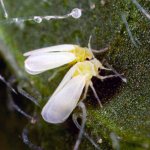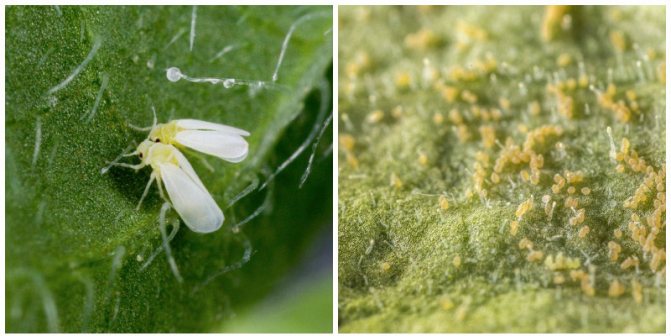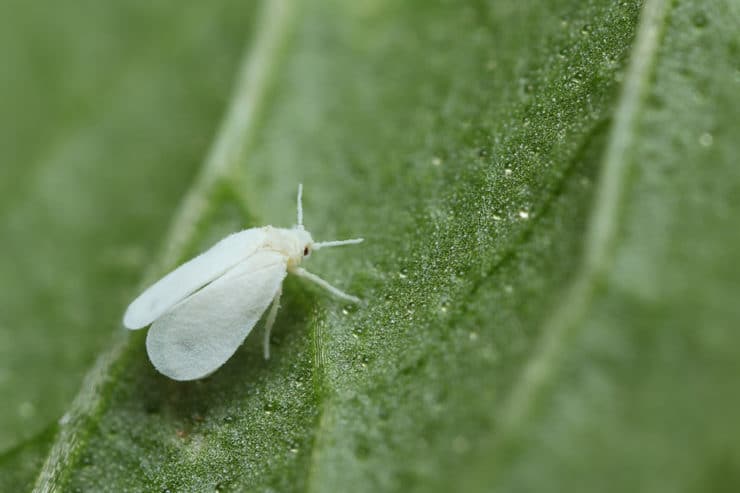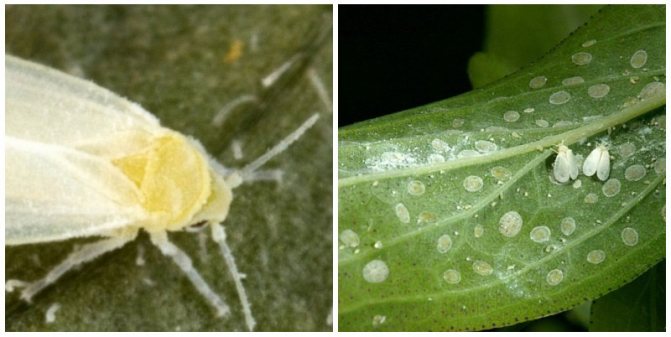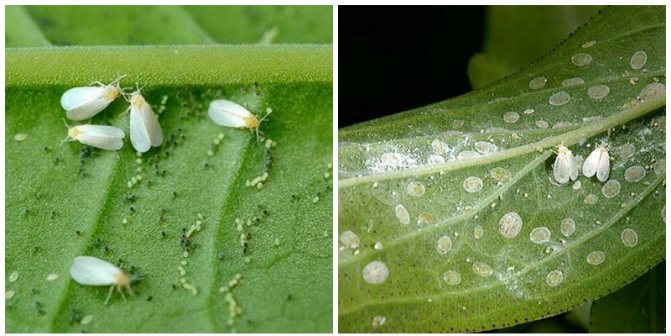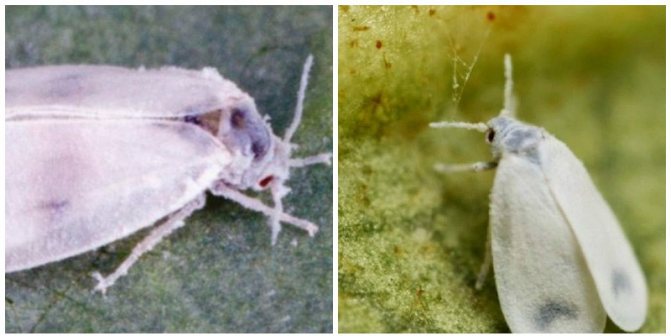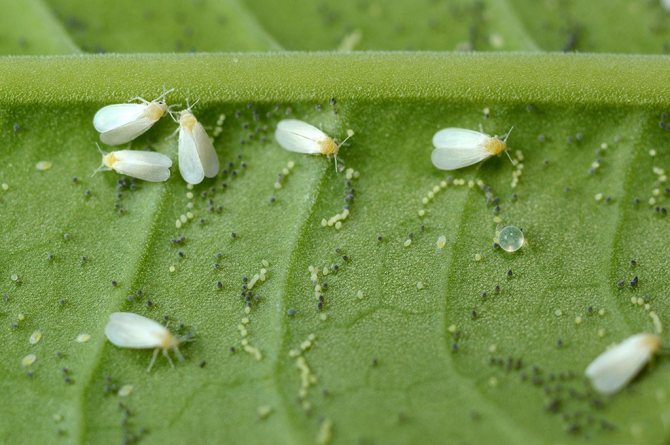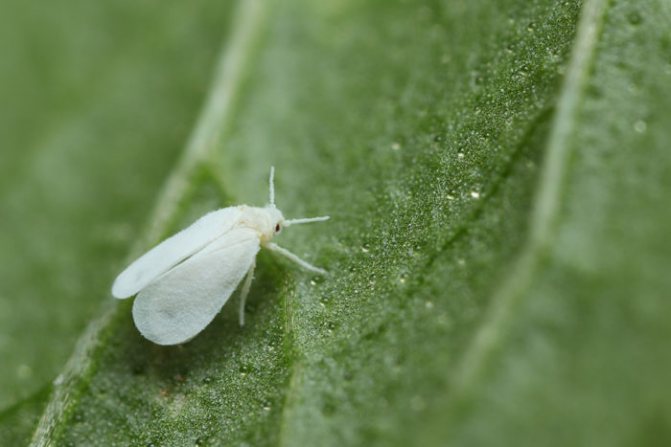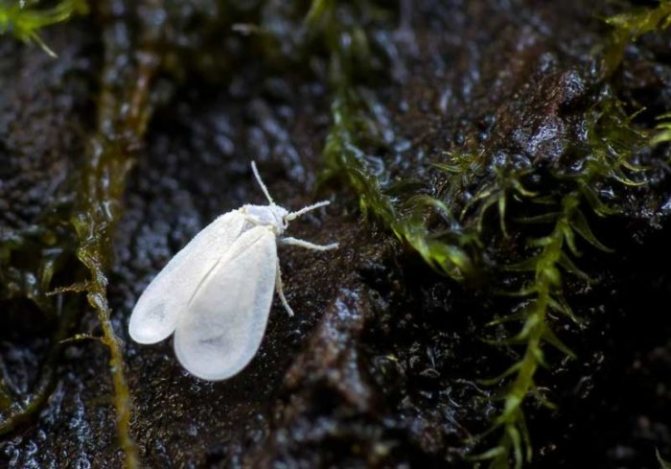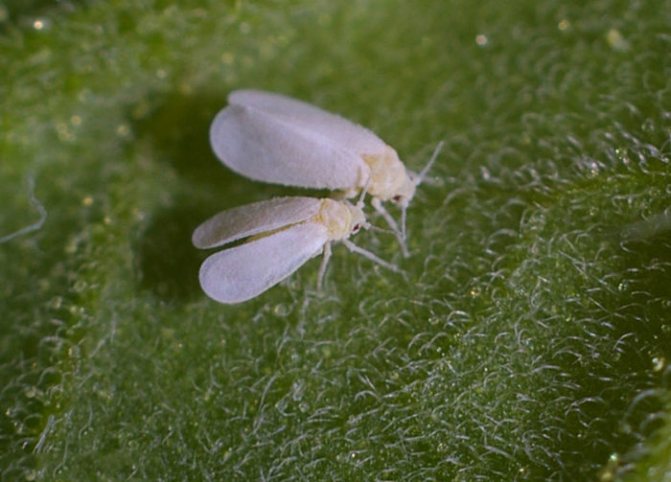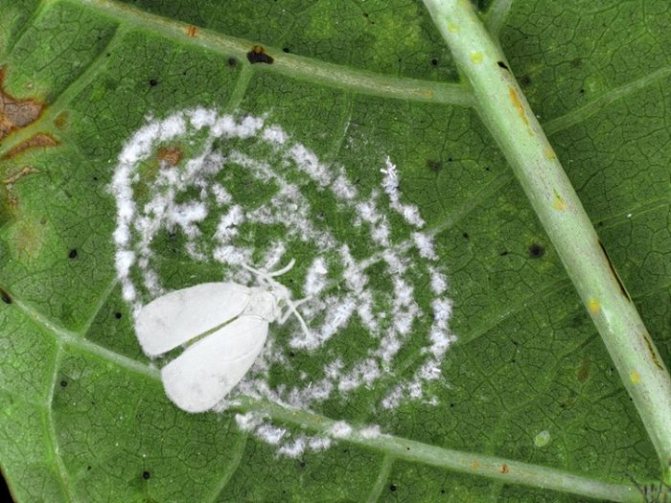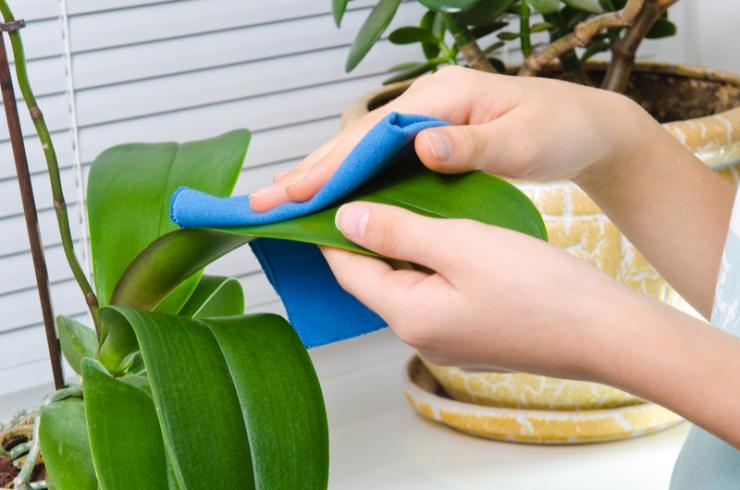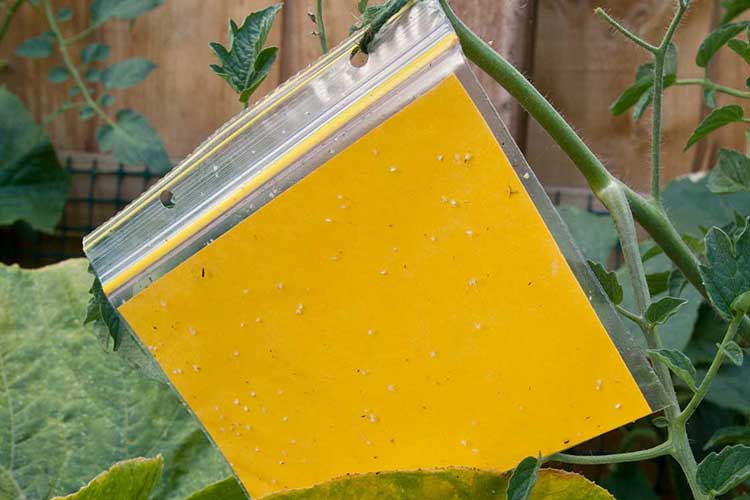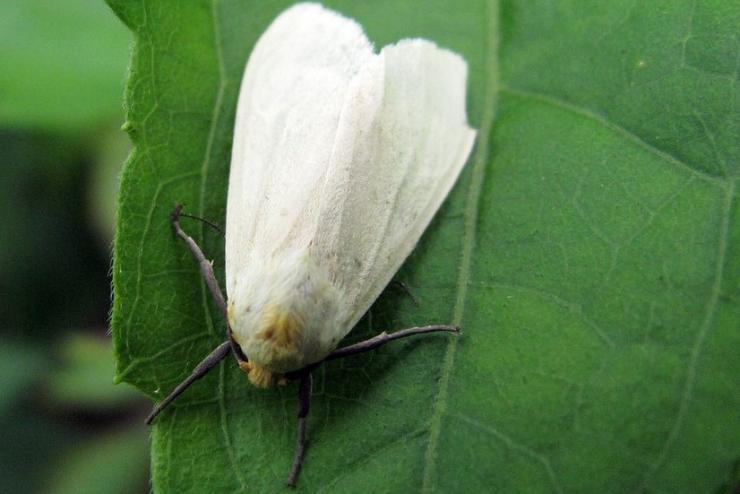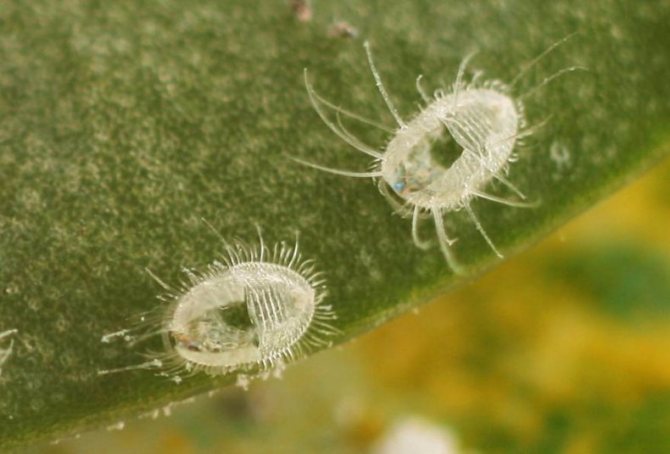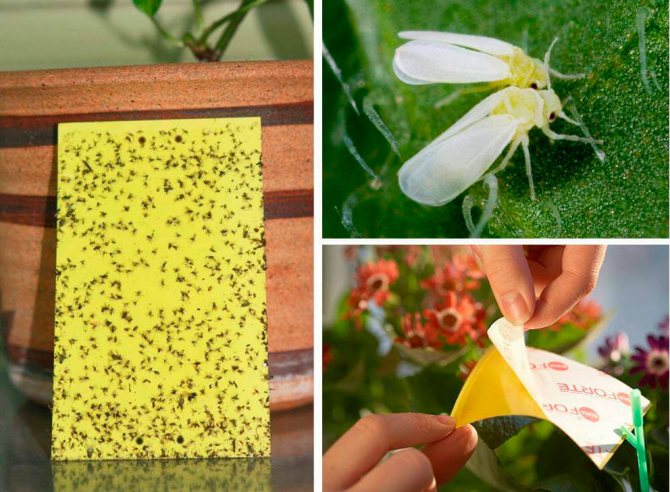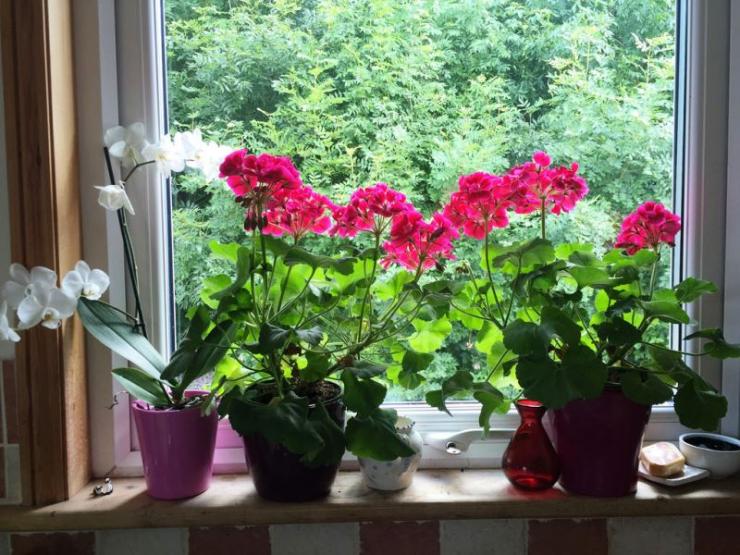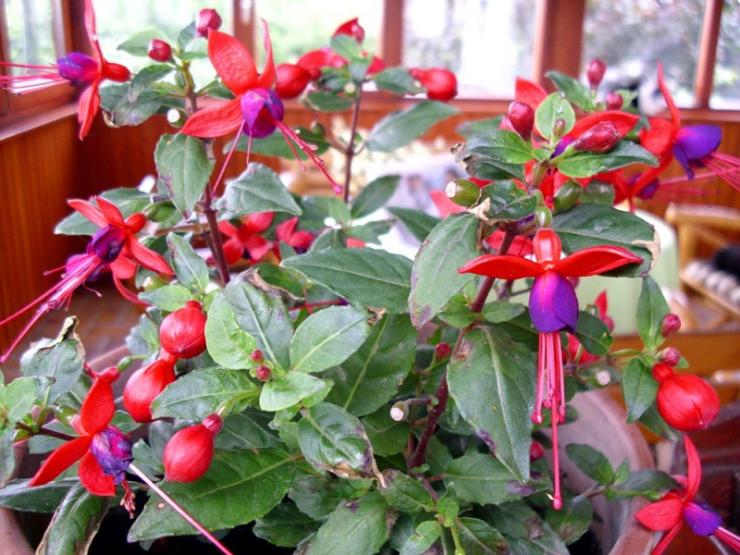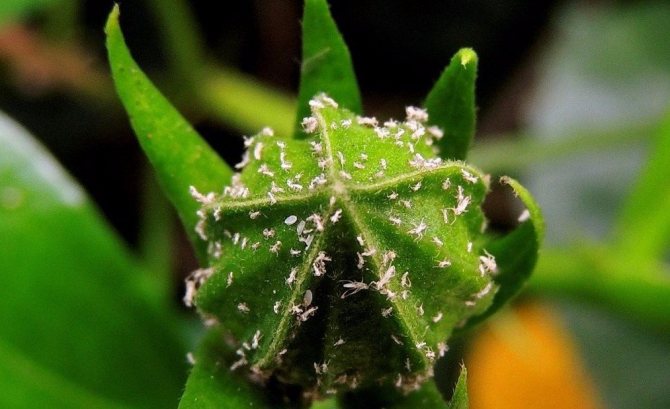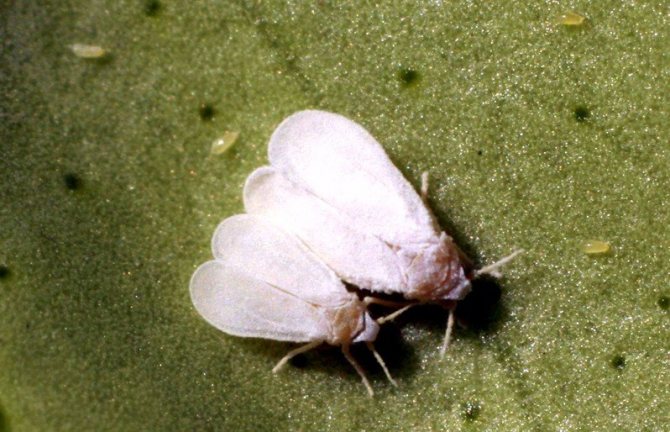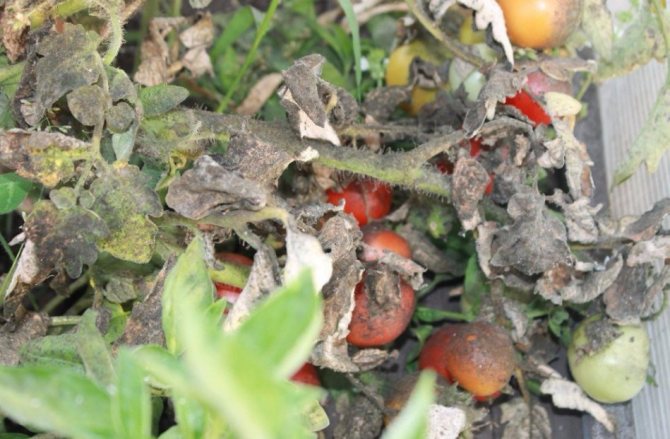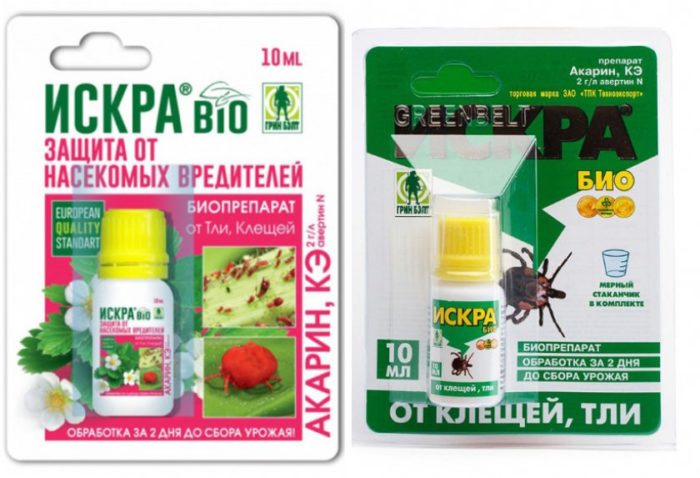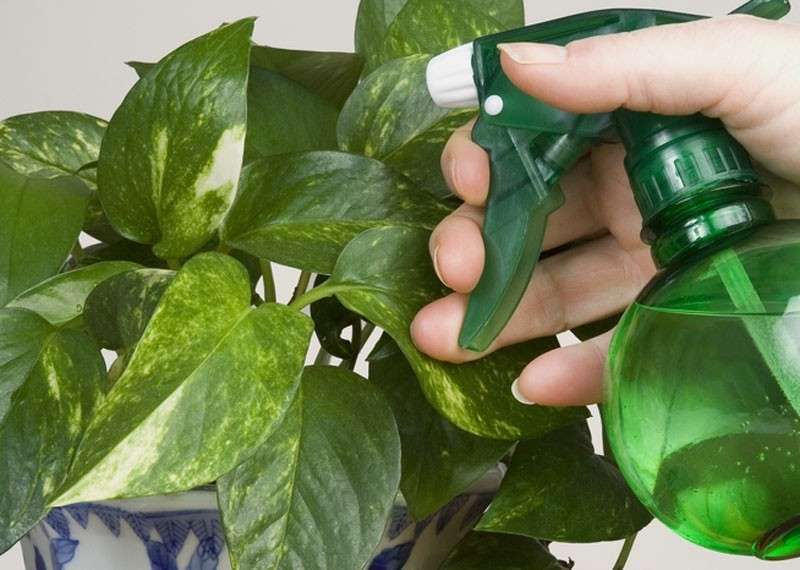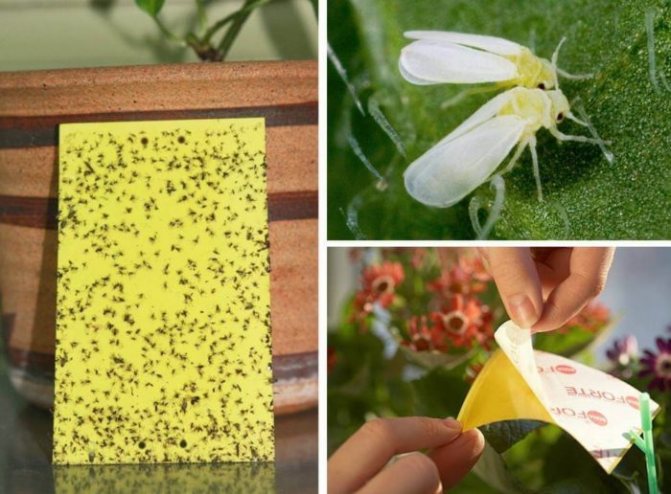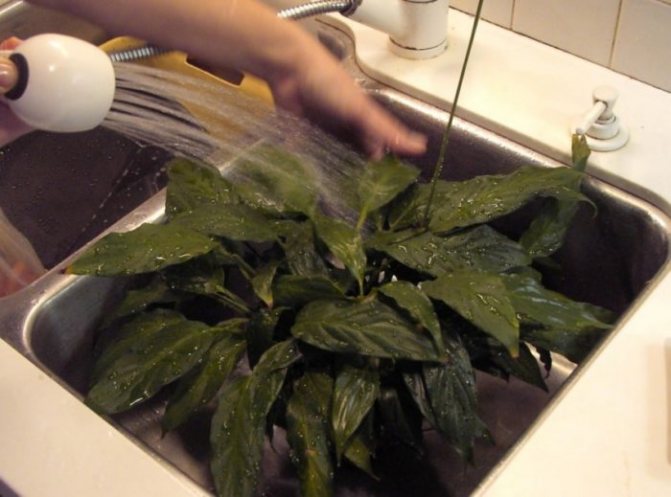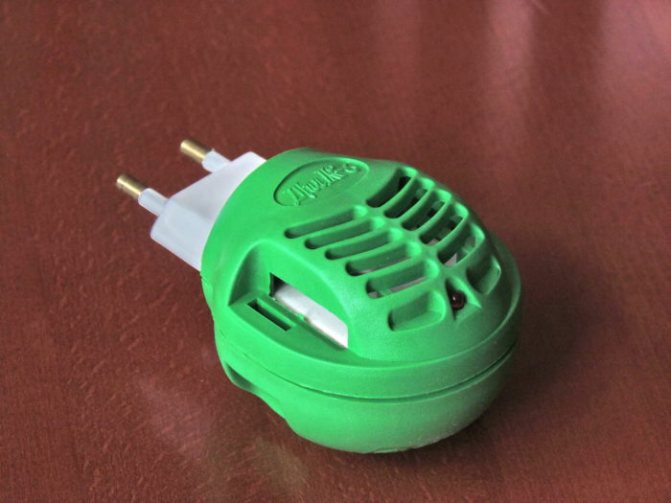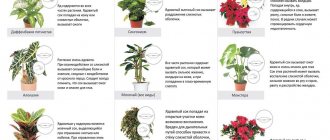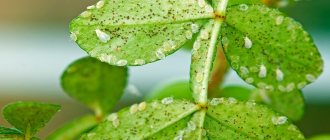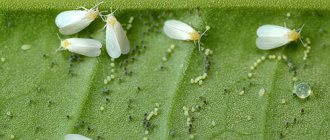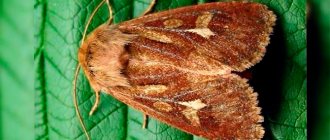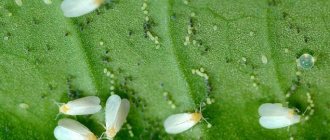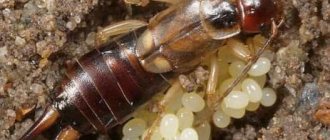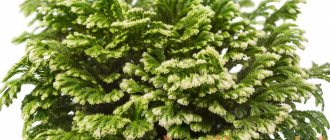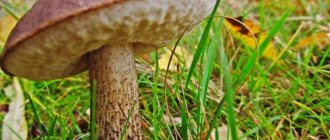Often, indoor plants begin to wilt, dry out or rot not at all because of poor care, but because they are affected by pests. One of them is the whitefly.
Almost two hundred species of this insect live in the wild. Initially, this parasite was distributed only in warm regions, but over time it has spread almost everywhere and is now the most common and dangerous pest not only vegetable crops, but indoor and greenhouse flowers.
Ornamental plants are usually infested with greenhouse (greenhouse), tobacco (cotton) and citrus whitefly.
Types and photos of whitefly
Whiteflies are very small (up to 2 millimeters) flying insects that resemble small white moths with wings covered with a waxy coating that resembles flour. It is from this feature that their name comes from.
The development of whiteflies has a rather complex form. Coming out of the egg, fast, flattened oval-shaped larvae, similar to gray croup, begin to actively search for a place to feed, moving up to fifteen hours in a row. Having found it, they adhere tightly to the plant, tucking their legs. At this time, their wax glands begin to work, which create a wax barrier, the latter is securely fixed on the surface of the leaves or stems of plants. Waxed Maggots completely protected from the effects of insecticides, and it is pointless to fight them at this stage of development.
After the stage of the first molt has passed, the size of the legs and whiskers begins to decrease in the larvae, they become completely immobilized. Their body shape begins to change dramatically, they swell in a wax capsule, stop feeding. At this moment, the formation of wings, legs, whiskers and other organs of an adult insect begins.
Insect reproduction is very fast. Every adult whitefly can lay 150 - 250 eggs on the inside of the leaves for every twenty-five days.
Under suitable conditions, with an air temperature of about 25 degrees and a humidity of 75 percent, one generation develops within three weeks. More than twelve tribes of parasites can form in a year.
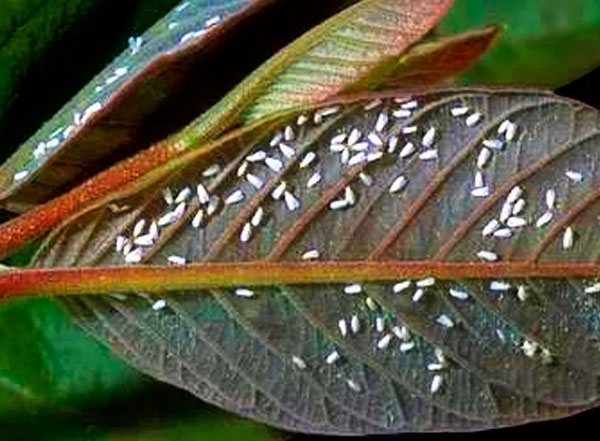
Tobacco (cotton) whitefly the most common type of this parasite, which is native to South Asia. It feels most comfortable at high air temperatures (about 35 degrees) and high humidity. In such conditions, she gives more than fifteen generations per year. It is an active carrier of many viral plant infections.
Greenhouse (greenhouse) whitefly... This species came to us from South America and now it feels very well in residential buildings and greenhouses, affecting ornamental plants. It is easily carried with the wind and actively reproduces throughout the year.
Citrus whitefly... Her homeland is South Asia. Despite the name, it affects not only citrus fruits, but also many other plant species, both outdoors and indoors. In Russia, its main habitat is the Caucasus (Black Sea coast).
Agrochemicals
First of all, it should be understood that the use of chemicals in residential premises should be done with extreme caution.Some chemicals should not be used at all in homes, apartments or offices, as they can cause significant harm to human health.
Spark Gold. The insecticide is designed to kill a wide range of pests; it can be used both outdoors and indoors. The drug practically does not emit a smell, it is absolutely safe for people, warm-blooded animals and plants. When preparing the mixture, the use of chlorinated water is unacceptable, in this case the active ingredients of the insecticide lose their effectiveness. Spark Zolotaya can be used both for preventive purposes and in the fight against a large number of whitefly and its larvae. In residential premises, no more than three sprays are allowed per season.
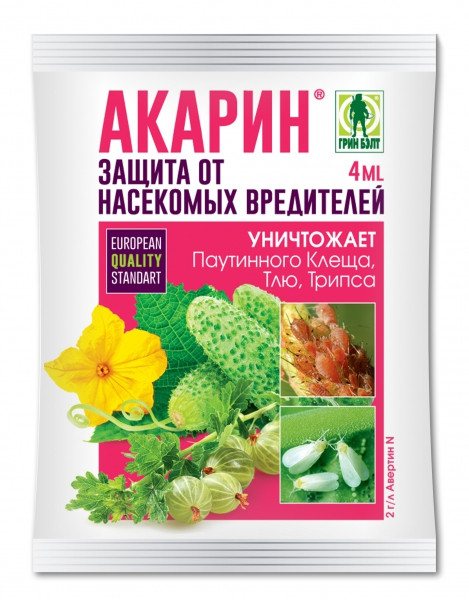

Akarin
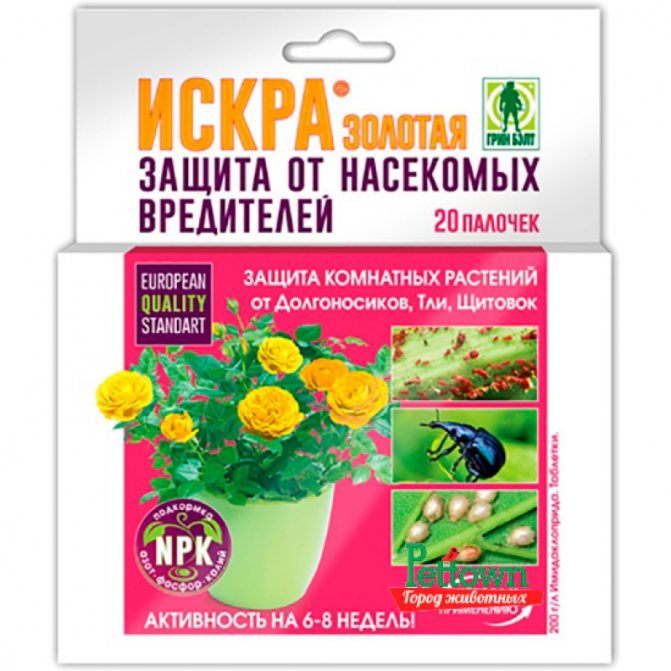

Spark Gold
Agravertine. The insecticide poses no threat to humans and does not emit an unpleasant odor, but at the same time it is able to effectively control a wide range of pests, including whitefly. To treat indoor plants, prepare a mixture based on the proportion: 5 milliliters of Agravertine per 2.5 liters of water. Spray the plant thoroughly and place it in the sun (but not in direct light) until completely dry. After a week, inspect the leaves, if you find a whitefly, re-process the plants.
Fitoverm. The drug belongs to the fourth class of toxicity, that is, it practically does not pose a threat to warm-blooded animals and humans. At the same time, it can harm bees and other beneficial animals - take this factor into account if you breed encarzia in a greenhouse. Insectoacaricide refers to chemicals of contact-intestinal action, with direct contact with the drug, the whitefly dies within 6-8 hours, the protection period in closed rooms: 18-20 days.
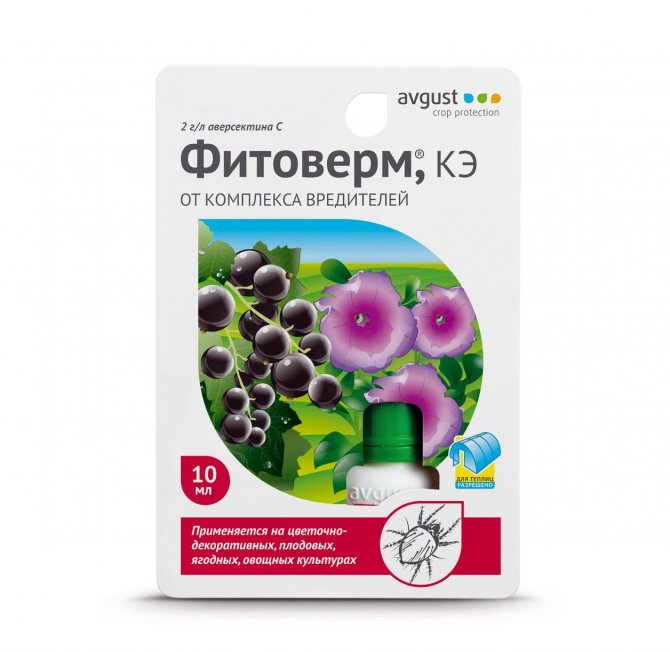

Fitoverm
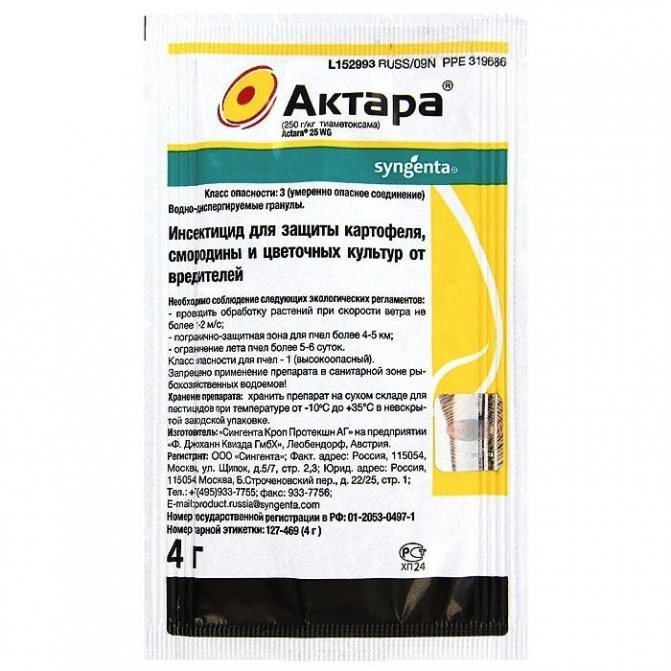

Aktara
Aktara. A contact-intestinal insecticide is used in the fight against a wide range of pests and is able to effectively control the whitefly. The drug can be used both for spraying plants and for soil treatment. We recommend using this insecticide when planting tubers or seedlings to disinfect the soil in tubs or greenhouses. Aktara has several important advantages over other insecticides. Firstly, it does not emit a smell and does not pose a threat to humans. The second advantage is the fact that the drug does not accumulate in the fruit. Thirdly, Aktara spreads through the systems of the plant: it can be used simply for watering the soil - the drug will rise up the plant to the very top.
Confidor. The insecticide is excellent at controlling adult insects and larvae of a wide range of pests. With its help, you can get rid of whiteflies, aphids, spider mites and other pests. The drug is characterized by low toxicity, it is completely safe for warm-blooded animals and people. Due to the fact that Confidor has a prolonged period of action, there is no need to carry out multiple spraying - one treatment is enough.
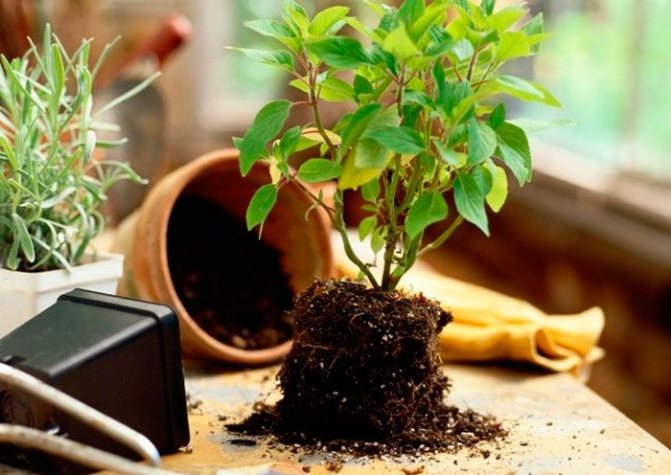

What does a whitefly infected plant look like?
It is not difficult to recognize a whitefly. If you touch the affected houseplant, the white moths will begin to fly off the leaves.
When inspecting infected specimens, an accumulation of eggs, larvae and adult insects can be found on the inside of the leaf, while the outside of the leaves is covered with yellow, shapeless spots and a shiny bloom - honeydew.
It is the excrement of parasites, on which a sooty fungus quickly begins to develop. As a result, the leaves begin to turn white and then turn completely black. The photo below shows what becomes of the leaf on which the whiteflies settled.
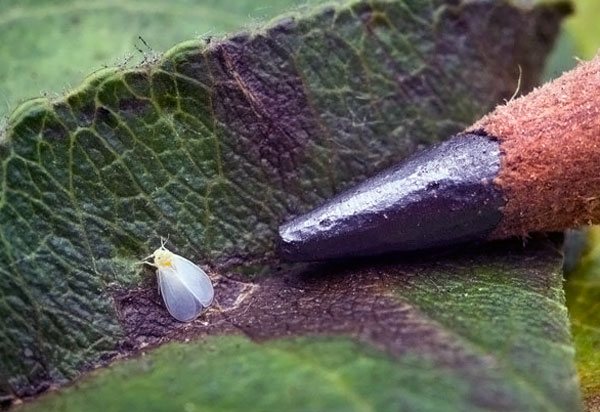

Whitefly description
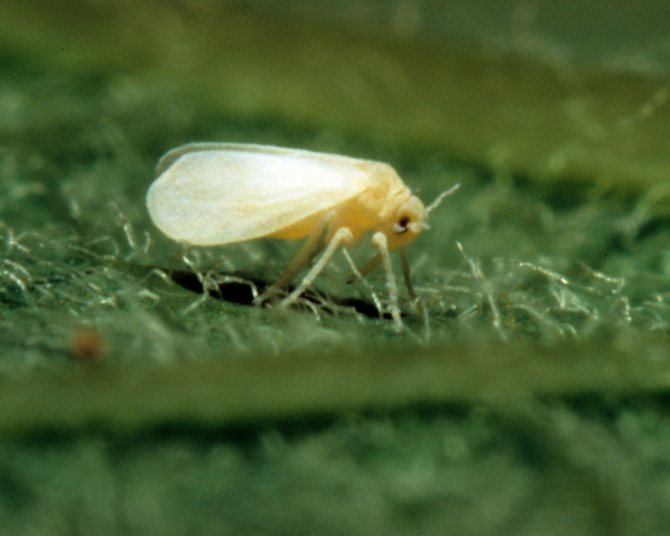

The white butterfly whitefly is a dangerous plant pest. Photo:
The small white butterfly resembles a moth. It is called the white death for the planted crops. Mostly they hide under the leaves, where they lay eggs. The eggs of the pest suck the nutritious juice from the plant, then leave sticky marks and subsequently a fungal disease develops.


Whitefly on tomato. Photo: fermer.blog
After the eggs of the whitefly suck out the nutrients, the leaves of the plant wither, turn black and fall off. Whitefly can infect a crop with deformation of shoots, which cannot be cured, but only destroy the infected crop, so that the disease does not begin to progress on other plants.
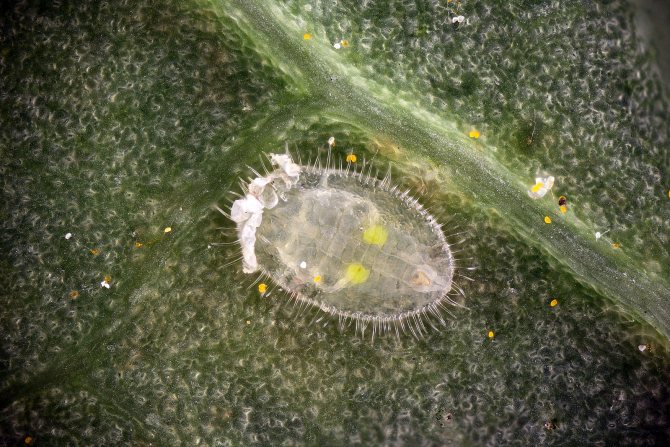

The pest lays about 200 eggs in its entire life, and she lives no more than a month. 15 generations of whiteflies can change in a year. From an egg, a whitefly turns into a butterfly in a short time - up to 40 days.
The reasons for the appearance can be untreated soil with disinfectants, as well as in places where there is high humidity.
Harm to indoor plants
The whitefly itself (larvae) harms houseplants by puncturing a leaf or shoot, it begins to actively suck out the juice. The plant gradually weakens, the leaves begin to curl, turn yellow and fall off. At the same time, parasites carried by various destructive viruses: yellow mosaic, jaundice, chlorosis, leaf curl. All this causes deformation of plants and a stop of their growth. And with a strong defeat, complete death.
Even more damage is caused by the sooty fungus, which is the result of the vital activity of the whitefly and can cause rotting of the plant.
The difference between a spider mite and a whitefly can be seen in the photo here.
And here is a detailed instruction on how to independently deal with the scabbard on indoor plants.
For you, we have created a step-by-step instruction on how to combat powdery mildew on roses.
Reasons for the appearance
The reasons for the appearance of the whitefly, like many other pests of indoor plants, are, as a rule, violations in their content:
- High temperature and humidity;
- Lack of regular ventilation;
- Densely standing plants (overcrowding);
- Infected newly acquired plants.
Despite the fact that this parasite is quite dangerous, it is also a delicate insect. At a temperature below fifteen degrees he dies, and its appearance again is impossible.
Prevention Tips
To prevent infestation of indoor flowers by parasitic insects, the following preventive measures are recommended:
- elimination of stagnation of water in pallets under the pots after watering;
- placing plants at a distance from each other, avoiding increased crowding;
- quarantine up to 7 days for each new flower;
- regular disposal of bushes from dead branches, dried leaves and inflorescences;
- keeping the plant in conditions of regular ventilation;
- using only tested or thoroughly sterilized soil;
- shower days - regular wiping of leaves and washing them under running cool water;
- the use of growth stimulants and fertilizers.
The health of ornamental plants depends on how much the owner takes care of them. The correct growing conditions, attentive attitude to the slightest changes in the condition, correctly applied top dressing - all this is the key to the health of flowers.
It is important to prevent the appearance of the whitefly in time, than to fight parasites with means of folk or industrial production.
5 / 5 ( 1 voice)
How to deal with whitefly most effectively
If you suspect that the plant is infected, you need to shake it and make sure that it is a whitefly. Since it is rather difficult to withdraw it, you need to apply complex measures to destroy it:
- To destroy adults, you need to hang glue traps near the infected plant that catch flies, you can also apply the treatment of the plant with a vacuum cleaner;
- Areas heavily populated with larvae must be removed;
- Rinse the remaining parts of the plant from accumulations of eggs and whitefly larvae with a solution of green or laundry soap (they are easily washed off);
- Loosen the top layers of the soil well.
After carrying out these preparatory work, you can start treating the plant with insecticides or folk remedies.
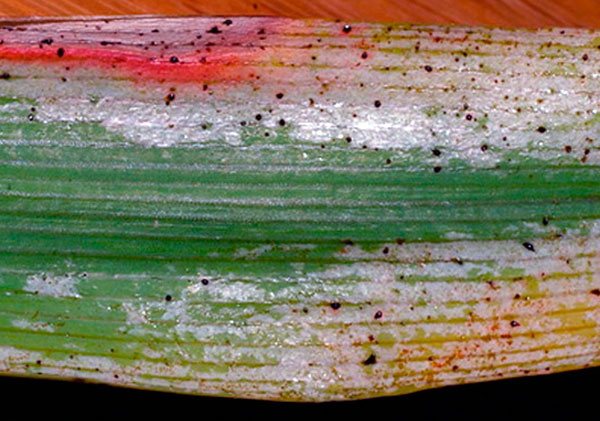

Signs of plant infection
The presence of a whitefly can be detected by the following signs:
- The larvae prefer to settle on the lower part of the leaf plate, there are also whitefly eggs there;
- You can detect the presence of a pest of indoor plants if you slightly shake the plant - a whole swarm of fluttering butterflies will appear;
- Another symptom of plant infection is a shiny sticky coating - this is how the waste products that are left by adults and larvae of the whitefly look like;
- Gray or black spots on the leaves of the plant indicate the presence of whitefly. This is nothing more than a sooty fungus, the emergence of which was provoked by the excrement of an insect;
- Yellowed and curled leaves, stunted growth and signs of wilting of the plant.
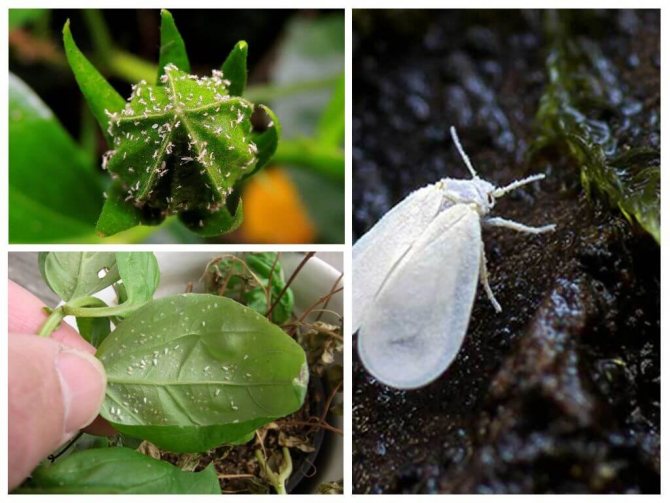

Whitefly in flowers
The whitefly often settles in the house on indoor flowers; it can be found on fuchsia, geranium, pelargonium or hibiscus. The pest also starts on balsam and pomegranate. Do not disdain midges and garden crops, she prefers to settle: on strawberries, celery, potatoes, tomatoes or cabbage.
How to deal with whitefly on indoor plants with insecticides
In case of severe damage to the plant, insecticide treatment is a necessary procedure. From the whitefly, you should choose a remedy that effectively acts on the sucking parasites.
Well suited for this Aktara, with which you can carry out both watering the soil and direct spraying of the pest on indoor flowers. For more active action, it can be used in combination with Actellik.
Has proven itself well in the fight against whitefly at home Tantrek... The effect of treatment with the drug persists for more than three weeks and is not destroyed by high temperatures.
Great for getting rid of parasites Fitoferm, which is a biological insecticide, very effective in small doses, does not damage plants (burns) and is completely safe for humans. Also used for the destruction of whitefly: Intavir, Ambush, Mospilan, Pirimifommetil, Cypermethrin, Fury and a number of other similar drugs.
If a small amount of shampoo or laundry soap is added to the insecticide solution, the effect of the drug will be longer. These substances act as an adhesive.
Whitefly: what is this insect?
Whitefly, or aleurodida, is an almost invisible parasite that destroys garden plants. The insect loves indoor flowers, tomato seedlings, peppers, cucumbers, eggplants. The parasite is especially common in greenhouse conditions. Individuals eat juicy foliage at all stages of life development. To get rid of a butterfly, you need to apply a whole range of preventive measures and use special means for treating summer cottages.
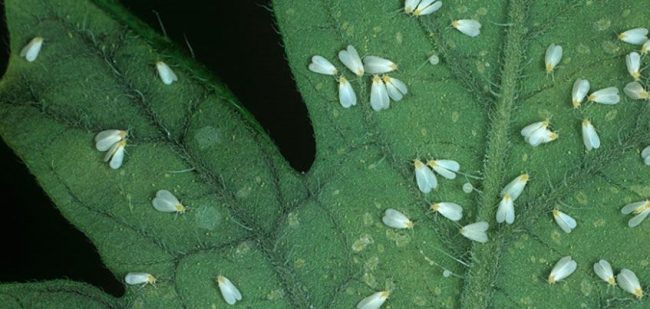

Varieties and classification of pests
There are about 1500 species of whiteflies in the world, which differ in habitat and food preferences. In greenhouse conditions, the parasite can constantly multiply, move, carry viral, fungal diseases. Eating the lower part of the stems, foliage leads to wilting of plants.Gradual damage to vegetable beds can significantly reduce yields.
Description of the main varieties of whiteflies found in temperate climates:
- Tobacco and cotton. The insect settles on various crops: turnips, beets, cabbage, indoor flowers, outdoor plants, tomatoes, potatoes.
- Greenhouse. It lives in the soil of greenhouses and greenhouses, where the climate is always temperate. Found on indoor plants in warm apartments. This whitefly feeds on vegetables or ornamental crops.
- Citrus. It feeds on tangerine, lemon, orange or lime leaves. In Russia, it is found in greenhouses or in the south of the Crimea, the Caucasus.
- Cabbage. It settles on cabbage, namely, it eats the leaves of the crop at the end of August.
- Strawberry. Whitefly eats strawberry foliage, reduces yield, harms plant fruits.
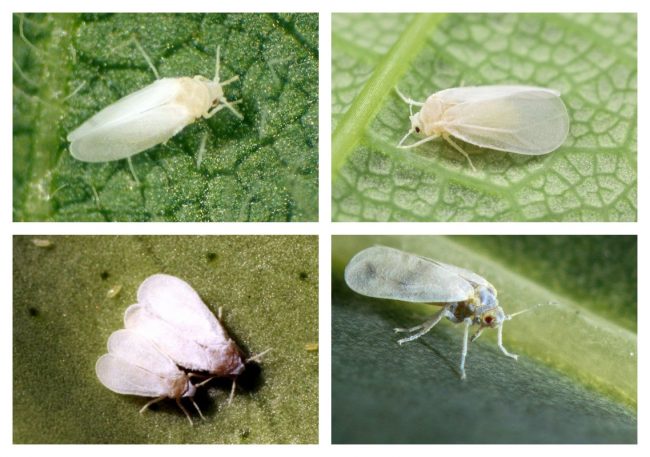

Cabbage and strawberry whitefly are not particularly dangerous for the garden and vegetable garden. The insect gives only one offspring for the entire season, and you can get rid of the invasion of butterflies by simply flushing the parasite with water. In apartments, aleurodids feed on fuchsia, begonia, orchid, geranium, balsam, passionflower or lantana. They can migrate to neighboring plants.
Habitat and suitable conditions for existence
Whiteflies love warmth and high humidity. Therefore, the parasite can develop year-round in greenhouses, while 3-4 generations are present in one area at once. In the garden or greenhouse, the parasite begins to appear en masse in July, when there is a strong heat (over 30 ° C). When the temperature drops below 10 ° C, adults and larvae die, but the eggs laid in the soil are able to winter.
It is interesting! You can meet the whitefly in home mini-greenhouses, which are organized on the windowsills. The insect affects seedlings, and then moves to indoor flowers.
Appearance
The whitefly looks like a small moth or white butterfly. The body length reaches 2-3 mm. The pest's wings are covered with a wax coating, which protects it from the effects of chemicals. The parasite larvae are located on the inner side of the leaf, on the lower stems of the culture. First instar worms have an oval shape, antennae, 6 legs. A couple of days after birth, the parasite settles in one place and looks like a microscopic whitish scale. When shaking the affected plant, a small cloud of small adults can be seen.
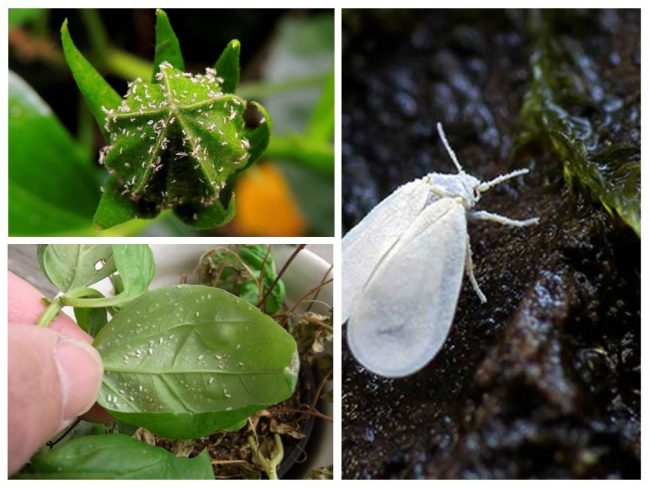

Whitefly life cycle
A female can mate up to 10 times in a month of her life. The life cycle of a parasitic butterfly includes many stages, which complicates the fight against the insect. The easiest way to get rid of the pest is in the period when the "vagrant" larvae appear, which become vulnerable in search of juicy leaves.
Whitefly maturation stages:
- an adult female lays eggs;
- after 14 days, whitefly larvae of the first instar appear from the clutch, which can search for a suitable habitat for a long time;
- larvae of the second instar stop at the most succulent areas and become covered with a waxy coating;
- larvae of 3-4 years old, or nymphs, eat well, but still do not have the ability to move.
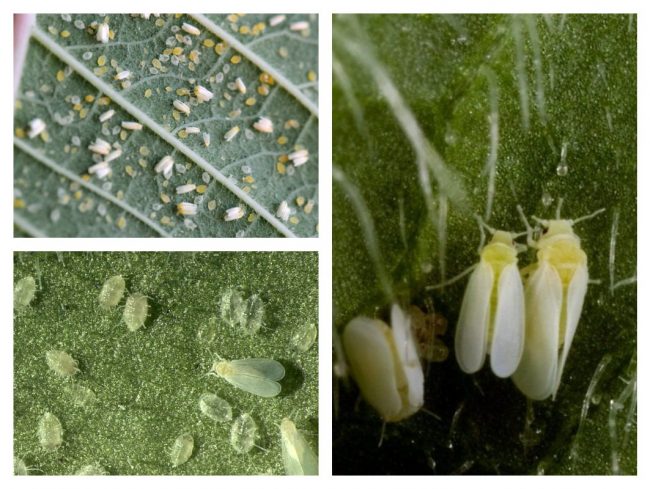

The cycle ends after the adult (imago) begins to move to neighboring plants, beds. Mating of a female with a male occurs 12-20 hours after departure. It is best to kill the insect at this stage, before it has time to lay eggs. Larvae of the second instar do not lend themselves to mechanical treatment, they are resistant to chemical spraying.
Reproduction and distribution
One individual in just a month of life is capable of laying up to 250 eggs or 15-20 eggs at a time. After 40 days, adult butterflies develop from the hatched whitefly larvae, which can migrate to other crops, move around the entire greenhouse or garden area with the help of the wind.The maximum number of the pest occurs in July-August, when hot and rainy weather prevails. With the onset of cold weather, the insect dies, but the eggs remain hibernating in the soil to begin their life cycle again in June.
How to get rid of whitefly using folk methods
If the defeat of the plant by the whitefly is in the initial stage, you can use folk methods of dealing with it, which are more gentle in relation to the plant:
- Pour the yarrow herb (100 grams) with one liter of boiling water and let it brew for at least a day. The broth is filtered and washed, and then the affected plants are sprayed;
- Pour three tablespoons of dry wormwood with one glass of boiling water and leave for about two hours. Strain the broth and rinse the infected areas of the plant with it;
- Dissolve two hundred grams of crushed laundry or green soap in one liter of water. Treat the plant well with the resulting solution. After a day, rinse it under warm, running water;
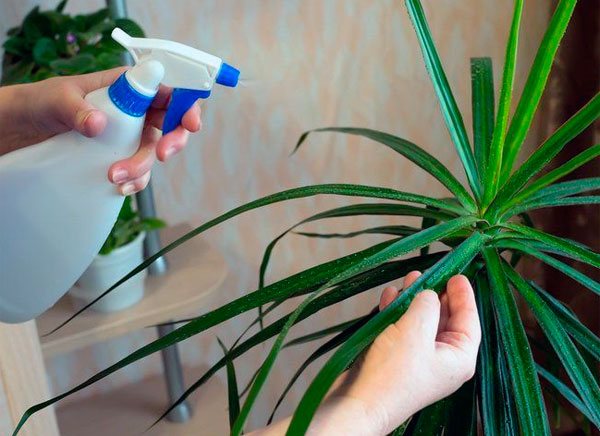

- Pour thirty grams of dandelion roots and forty grams of leaves with one liter of cold water, let stand for six hours, strain. Spray the plant, repeat the procedure in two weeks;
- One hundred grams of dried citrus peels are steamed with one liter of boiling water and infused for five hours. You can fill it with cold water for two days. After that, the infusion must be filtered, add five grams of green or laundry soap to it and process the plant. This composition can be stored in the refrigerator for no more than three days;
- Insist ten grams of crushed garlic in one liter of water for a day, strain, spray.
Plants treated in any way should be temporarily placed in a cool and dry room.
According to numerous observations, whiteflies really like the color yellow. Therefore, a yellow sheet of paper or cardboard, smeared with petroleum jelly or other sticky agent, will help get rid of adults.

